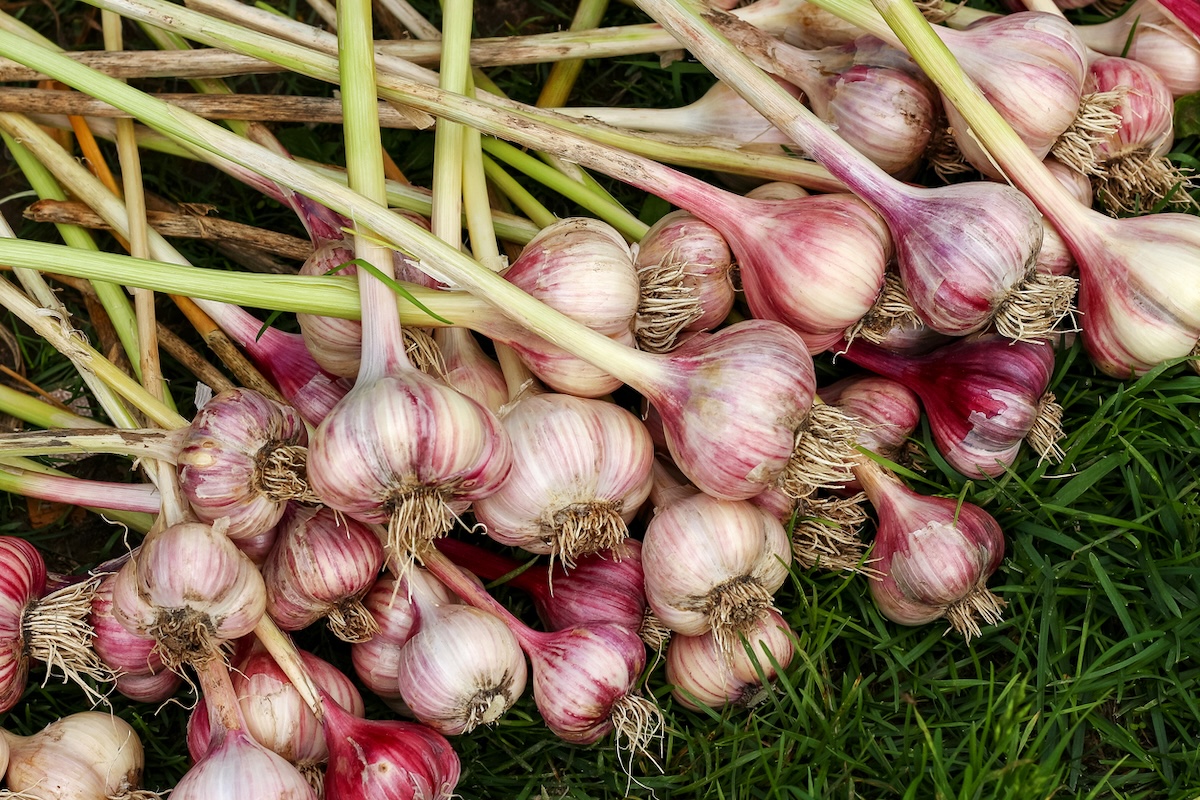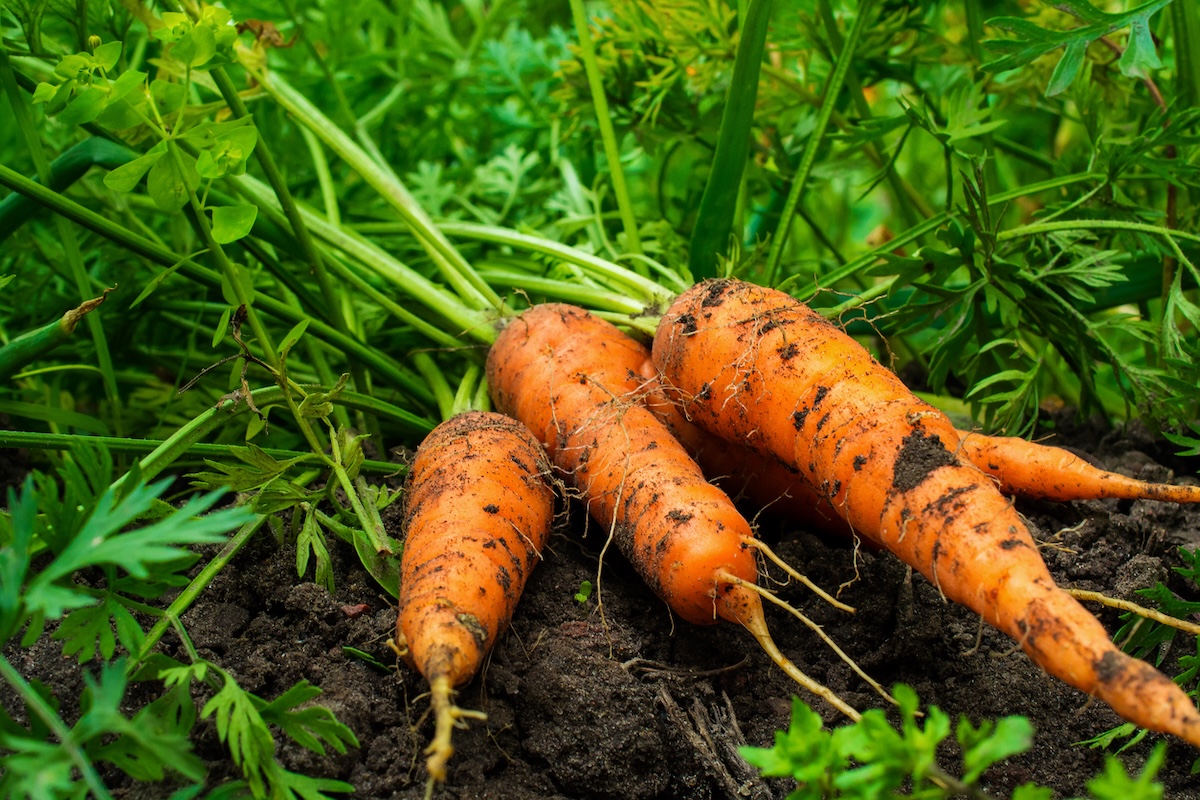We may earn revenue from the products available on this page and participate in affiliate programs. Learn More ›
If those plump farmer’s market tomatoes leave you green with envy, it’s probably time to try growing your own tomato plants. From cherry tomatoes to heirloom beefsteak, there are as many tomato varieties as there are recipes. Not only are tomatoes packed with nutrients, they are surprisingly easy to grow, especially if you take advantage of companion planting.
“When planning the layout of your garden, consider companion planting to help maximize growing space and discourage pests from invading your growing plants,” says Rebecca Sears, chief marketing officer at Ferry-Morse. The good news is, when it comes to companion planting with tomatoes there are plenty of possibilities. From garlic and basil to sunflowers and roses, many plants can help ensure success for the home gardener when planting tomatoes.
Deter Pests and Diseases, Attract Beneficial Insects
Garlic, basil, and tomatoes go well together on the stovetop, and they do wonders for each other in the garden. So do a host of other tomato companion plants by attracting pollinators and beneficial insects, as well as helping to reduce pests and diseases. Even hanging tomato plants can benefit from the addition of companion plantings for tomatoes. Gardeners can place plants like chives and marigolds in pots placed strategically near the hanging tomato pots.
Garlic (Allium sativum)

Garlic has been used by gardeners for centuries to ward off pests (and vampires) and in particular, as Lousie Riottte notes in her book on companion planting, Carrots Love Tomatoes, red spider mites. Folk wisdom is backed up by science, too. A study from the University of California’s agriculture and pest management program cites garlic extract as an effective biological control against mites. Just be sure the tomato plants don’t create too much shade for sun-loving garlic.
Best For: Best for repelling insects, especially spider mites and aphids.
Our Recommendation: Get Transylvanian Garlic Bulbs at Burpee for $16.95.
Marigold (Tagetes spp.)

Marigold’s bright orange and yellow flowers are a welcome sight in the garden, but not just because they look cheery. Marigold flowers contain a natural insect repellent called pyrethrin that repels a host of insects including aphids, thrips, and spider mites; they can attract some insects that attack tomato pests. In addition, studies have shown that marigolds can help prevent whitefly populations on companion tomatoes. Marigolds also attract pollinators that are beneficial to the setting of tomato fruits.
Best For: Repelling insects that harm tomato plants and attracting beneficial insects.
Our Recommendation: Get Double French Dwarf Marigold Seeds at Ferry-Morse for $2.99
Chives (Allium schoenoprasum)

Garlic, chives, and onions are in the same plant family (Allium), which means they offer many of the same pest-deterring attributes. Chives also make beautiful companion plants in the garden if allowed to flower; their flowers will attract a huge number of bees and other pollinators.
Best For: Repelling pests and attracting pollinators.
Our Recommendation: Get Chives Seeds at Park Seed for $4.95.
Nasturtium (Tropaeolum majus)

Nasturtium produces beautiful tunnel-shaped flowers that pollinators such as hummingbirds and butterflies love for sipping nectar. In addition, they attract hoverflies, who are known predators of aphid larvae. Nasturtiums also repel whiteflies, along with a number of other annoying garden pests like potato bugs and squash bugs. Plus, nasturtium flowers and leaves are edible.
Best For: Attracting beneficial insects and pollinators, and repelling pests.
Our Recommendation: Get Peach Melba Nasturtium Seeds at Botanical Interests for $2.49.
Basil (Ocimum basilicum)

Gardener’s folk wisdom tells us that basil makes tomatoes sweeter but there’s also plenty of evidence that basil helps tomatoes in another way. “Basil is an excellent companion plant for tomatoes because it is thought to repel pests like hornworms and thrips,” says Sears. “Plus it grows easily under a tall tomato vine, maximizing space.” Thrips damage is problematic for tomato growers because thrips are known to transmit diseases, including the tomato spotted wilt virus, which affects leaves and fruit.
Best For: Repelling thrips, hornworms, and other pests.
Our Recommendation: Get Italian Genovese Basil Seeds at Ferry Morse for $3.49.
Improve Soil Structure, Nutrients, Tomato Flavor
Companion planting for tomatoes isn’t exclusive to plants that repel pests. There are also several easy-to-grow vegetables that make good companion plants for tomatoes by helping to keep the soil moist, well-draining, and packed with nutrients, important aspects of growing healthy tomato plants.
Lettuce (Lactuca sativa)

Lettuce is a low-growing and relatively compact plant. Lettuce likes things on the cool side, so the loose or head lettuces don’t mind the shade that tomatoes provide as they grow. Companion planting tomatoes and lettuce has other benefits, too. “Lettuce is another great companion plant for tomatoes, as it can help conserve soil moisture by covering the soil and it doesn’t take away excessive nutrients from tomatoes,” Sears says.
Best For: Helping keep soil moist.
Our Recommendation: Get Grand Rapids Lettuce Seeds at Ferry-Morse for $3.49.
Sugar Snap Peas (Pisum sativum var. macrocarpon)

Peas and other legumes are nitrogen-fixing plants, which means they take nitrogen from the air and help replicate it in the soil around their roots. This helps improve the quality of the soil and makes nitrogen more available for tomatoes to grow. Sugar snap peas also flower, which attracts pollinators. Peas require structure, so take this into account when planning the garden bed; if they lack support and are too close to tomatoes, this will decrease air circulation for both plants.
Best For: Increasing nitrogen in the soil.
Our Recommendation: Get Sugar Snap Pea Seeds at Burpee for $5.45.
Carrot (Daucus carota subsp. sativus)

Carrots and tomatoes make excellent garden bedfellows because carrots develop long tap roots that help keep the soil more permeable. They also won’t compete with tomatoes for soil moisture or nutrients. Plus, carrots prefer cool weather, so like lettuce, they benefit from the shade that tomatoes provide them, allowing gardeners to extend their carrot crops further into the heat of summer.
Best For: Keeping the soil permeable and not competing with tomatoes for nutrients or moisture.
Our Recommendation: Get Tendersweet Carrot Seeds at Gurney’s for $2.99.
Pole Beans (Phaseolus vulgaris)

Just as with growing peas and other legumes, beans improve the soil by fixing nitrogen. Try planting pole beans in alternating rows with tomatoes, making sure you are giving both plenty of space to grow. Unlike bush beans, pole beans require more support, so be sure to give them something to climb on so they don’t overtake the tomato cages. Pole beans grow rapidly and can be sowed in the ground after tomatoes are established.
Best For: Fixing nitrogen in the soil.
Our Recommendation: Get Jack’s Magic Pole Beans at Ferry-Morse for $1.96.
Asparagus (Asparagus officinalis)

If tomato plants are planted in late spring after asparagus shoots begin to break through the soil, the tomato helps protect the tender shoots from the dreaded asparagus beetle. That’s because tomatoes and other members of the nightshade family (Solanaceae) contain solanine, a known beetle repellent. Meanwhile, asparagus deters root-knot nematodes, helping to prevent the nematodes from destroying tomato plant roots during their critical stage of establishment in the garden.
Best For: Repelling root-knot nematodes, tender asparagus is in turn protected from asparagus beetles.
Our Recommendation: Get Mary Washington Asparagus Seeds at Burpee for $3.95.
Similar or Non-Competing Space, Conditions, Growth Habit
Tomatoes thrive in the heat of the summer, so the best time to plant tomatoes is late spring and early summer. Because of this, some of the best companion plants for tomatoes include vegetables that are grown during the shoulder seasons of early spring and fall, such as beets and celery. Other plants won’t compete with tomatoes for space or have similar growing periods, making it easy to care for both.
Beets (Beta vulgaris)

Beets prefer cool weather and in some climates can even be grown into winter. Like other root vegetables, they help break up the soil. Beets can be set out much earlier in the spring than heat-loving tomatoes, so they’ll be ready to harvest when tomato seedlings are growing. Alternatively, they can be planted after short-lived summer vegetables like peas have been harvested.
Best For: Breaking up the soil, not competing during peak growing season.
Our Recommendation: Get Early Wonder Beet Seeds at Botanical Interests for $2.69.
Rose (Rosa spp.)

A rose may not seem like the most obvious choice for a tomato bed, but there are a few benefits to planting roses nearby. Bush roses maintain a sturdy structure and are easy to prune away from tomatoes as they grow, and roses produce beautiful flowers that attract beneficial insects. The alkaloid in tomatoes, solanine, can reduce the occurrence of black spot on rose leaves. Just be sure to allow both plants enough space and plenty of air circulation.
Best For: Attracting pollinators; tomatoes help control black spot on roses.
Our Recommendation: Get the Fairy Shrub Rose at Jackson & Perkins for $49.95.
Pumpkin (Cucurbita pepo)

Pumpkins and tomatoes have similar growth periods, making it possible to tend to the water and nutrient needs of both on the same cycle. Additionally, pumpkins and other squash can make good companions for tomatoes because they are spreaders and can create a natural shade for the ground around tomato plants, helping to prevent water loss in the peak of summer heat. Larger varieties of pumpkins can take over a bed, so opt for miniature pumpkins if planted in closer proximity to avoid overcrowding.
Best For: Protecting water loss in soil and not competing for nutrients.
Our Recommendation: Get Jack Be Little Pumpkin seeds at Burpee for $4.95
Sunflowers (Helianthus annuus)

Sunflowers grow taller than tomatoes so they don’t compete for space, plus the big beautiful flowers tend to attract pollinators, helping tomatoes set more fruit. Plant sunflowers so they don’t crowd out or block sun from reaching tomatoes, but near enough to bring bees to both plants.
Best For: Won’t compete with tomatoes for space, attracts pollinators.
Our Recommendation: Get Mammoth Sunflower seeds at Burpee for $5.45.
Celery (Apium graveolens)

Celery is a cool-season crop, so it makes a good shoulder-season planting near tomatoes. Celery can be planted in the same bed as tomatoes, and as the hotter weather comes during the summer, the shade of the tomatoes will help protect the celery until harvest.
Best For: Not competing with tomatoes for space or nutrients, taking advantage of tomato’s shade.
Our Recommendation: Get Tall Utah Celery Seeds at Ferry-Morse for $3.49.
5 Plants Never to Grow Near Tomatoes
Good companion plants for tomatoes can help a garden grow, but planting incompatible vegetables and herbs near one another is among common garden mistakes people make. Here are a few plants to avoid planting near tomatoes.
- Brassicas: Any plant in the Brassica family, which includes broccoli, cauliflower, kale, kohlrabi, and cabbage, tend to attract pests like aphids and cabbage worms, which can harm tomatoes. They will also compete with tomatoes for the same nutrients in the soil.
- Corn: Tomatoes and corn attract similar pests and fungal infections, so they are best kept apart in the garden.
- Potatoes: Not only will tomatoes and potatoes compete with each other for nutrients, but tomatoes will make potatoes more susceptible to potato blight.
- Tobacco: Tobacco can expose tomatoes to the tobacco mosaic virus, which will quickly destroy every tomato plant in the garden. For this reason, smokers should always wash their hands thoroughly before handling any tomato plant.
- Fennel: Fennel has compounds that suppress the growth of nearly all plants around it, so for this reason avoid planting fennel in the vegetable garden.


